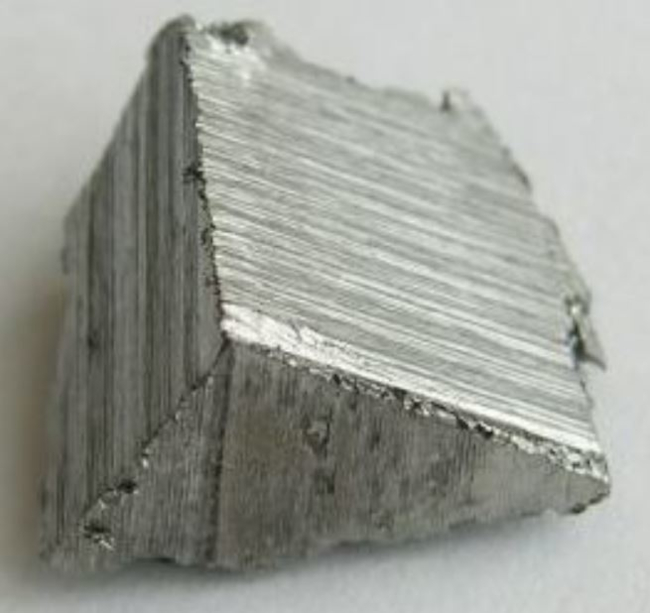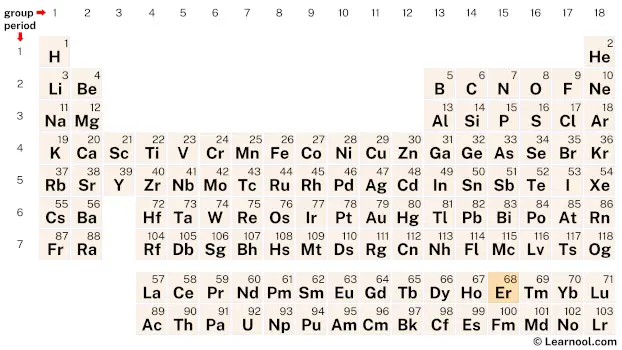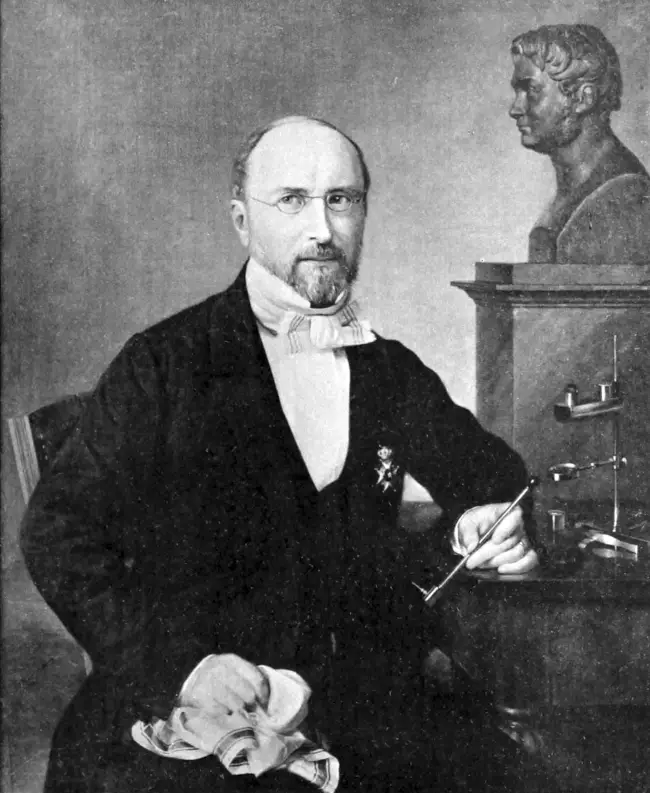
Erbium (Er) is a chemical element of the periodic table, located in the period 6, and has the atomic number 68. It is the twelfth element in the lanthanide series. It is a soft, malleable, lustrous, silvery-white metal, which is named after Ytterby, a village in Sweden, where it was mined. It is never found freely in nature and is counted as one of the rare earth elements.
On periodic table
| group | ⇨ | 1 | 2 | 3 | 4 | 5 | 6 | 7 | 8 | 9 | 10 | 11 | 12 | 13 | 14 | 15 | 16 | 17 | 18 |
| period | ⇩ | ||||||||||||||||||
| 1 | 1 H  Hydrogen |
2 He  Helium |
|||||||||||||||||
| 2 | 3 Li  Lithium |
4 Be  Beryllium |
5 B  Boron |
6 C  Carbon |
7 N  Nitrogen |
8 O  Oxygen |
9 F  Fluorine |
10 Ne  Neon |
|||||||||||
| 3 | 11 Na  Sodium |
12 Mg  Magnesium |
13 Al  Aluminium |
14 Si Silicon |
15 P  Phosphorus |
16 S  Sulfur |
17 Cl  Chlorine |
18 Ar  Argon |
|||||||||||
| 4 | 19 K  Potassium |
20 Ca  Calcium |
21 Sc  Scandium |
22 Ti  Titanium |
23 V  Vanadium |
24 Cr  Chromium |
25 Mn  Manganese |
26 Fe  Iron |
27 Co  Cobalt |
28 Ni  Nickel |
29 Cu  Copper |
30 Zn  Zinc |
31 Ga  Gallium |
32 Ge  Germanium |
33 As  Arsenic |
34 Se  Selenium |
35 Br  Bromine |
36 Kr  Krypton |
|
| 5 | 37 Rb  Rubidium |
38 Sr  Strontium |
39 Y  Yttrium |
40 Zr  Zirconium |
41 Nb  Niobium |
42 Mo  Molybdenum |
43 Tc  Technetium |
44 Ru  Ruthenium |
45 Rh  Rhodium |
46 Pd  Palladium |
47 Ag  Silver |
48 Cd  Cadmium |
49 In  Indium |
50 Sn  Tin |
51 Sb  Antimony |
52 Te  Tellurium |
53 I  Iodine |
54 Xe  Xenon |
|
| 6 | 55 Cs  Caesium |
56 Ba  Barium |
72 Hf  Hafnium |
73 Ta  Tantalum |
74 W  Tungsten |
75 Re  Rhenium |
76 Os  Osmium |
77 Ir  Iridium |
78 Pt  Platinum |
79 Au  Gold |
80 Hg  Mercury |
81 Tl  Thallium |
82 Pb  Lead |
83 Bi  Bismuth |
84 Po  Polonium |
85 At  Astatine |
86 Rn  Radon |
||
| 7 | 87 Fr  Francium |
88 Ra  Radium |
104 Rf  Rutherfordium |
105 Db  Dubnium |
106 Sg  Seaborgium |
107 Bh  Bohrium |
108 Hs  Hassium |
109 Mt  Meitnerium |
110 Ds  Darmstadtium |
111 Rg  Roentgenium |
112 Cn  Copernicium |
113 Nh  Nihonium |
114 Fl  Flerovium |
115 Mc  Moscovium |
116 Lv  Livermorium |
117 Ts  Tennessine |
118 Og  Oganesson |
||
| 57 La  Lanthanum |
58 Ce  Cerium |
59 Pr  Praseodymium |
60 Nd  Neodymium |
61 Pm  Promethium |
62 Sm  Samarium |
63 Eu  Europium |
64 Gd  Gadolinium |
65 Tb  Terbium |
66 Dy  Dysprosium |
67 Ho  Holmium |
68 Er Erbium |
69 Tm  Thulium |
70 Yb  Ytterbium |
71 Lu  Lutetium |
|||||
| 89 Ac  Actinium |
90 Th  Thorium |
91 Pa  Protactinium |
92 U  Uranium |
93 Np  Neptunium |
94 Pu  Plutonium |
95 Am  Americium |
96 Cm  Curium |
97 Bk  Berkelium |
98 Cf  Californium |
99 Es  Einsteinium |
100 Fm  Fermium |
101 Md  Mendelevium |
102 No  Nobelium |
103 Lr  Lawrencium |
|||||
| – f block |
Erbium is found in the lanthanide series, a group of elements located at the bottom of the periodic table. Specifically, in period 6, between holmium (Ho) and thulium (Tm).
Element information
 |
|
 |
|
| Origin of name | named after Ytterby, a village in Sweden |
| Symbol | Er |
| Atomic number (Z) | 68 |
| Atomic mass | 167.259 u |
| Block | f-block |
| Period | 6 |
| Classification | Lanthanide |
| Atomic radius | 176 pm |
| Covalent radius | 189±6 pm |
| Melting point | 1529 ℃, 2784 ℉, 1802 K |
| Boiling point | 2868 ℃, 5194 ℉, 3141 K |
| Electron configuration | [Xe] 4f12 6s2 |
| Learn how to write: Erbium electron configuration | |
| Electrons per shell | 2, 8, 18, 30, 8, 2 |
| Crystal structure | Hexagonal close-packed (hcp) |
| Phase at r.t | Solid |
| Density near r.t | 9.066 g/cm3 |
| Main isotopes | Erbium-162, Erbium-164, Erbium-166, Erbium-167, Erbium-168, Erbium-170 |
| Natural occurrence | Primordial |
| Oxidation state | +3 |
| Electronegativity (Pauling scale) | 1.24 |
| Protons Neutrons Electrons |
68 99 68 |
| CAS number | 7440-52-0 |
| Discovered by | Carl Gustaf Mosander in 1843 |
History

Erbium was first discovered in 1843 by Swedish chemist Carl Gustaf Mosander. Mosander discovered the element while analyzing a sample of yttria, a rare earth mineral that was discovered in Ytterby, Sweden. Mosander’s yttria sample contained three distinct oxides, which he named yttria, erbia, and terbia. Mosander found that erbia was the component of the sample that produced a pink color in solution.
Mosander’s erbia was later found to contain several other rare earth elements, including scandium, yttrium, holmium, and thulium. For many years, the term “erbia” was used to describe a group of rare earth oxides that contained varying amounts of erbium. In 1877, French chemist Paul Émile Lecoq de Boisbaudran was able to isolate erbium from Mosander’s erbia sample through a series of fractional crystallizations.
Erbium’s name comes from the Latin word “Erbia,” which is the old name for Ytterby, the Swedish village where the original yttria sample was discovered. The discovery of erbium, along with the other rare earth elements, opened up new avenues for research in chemistry and physics, as these elements exhibited unique properties and behaviors that were not seen in other elements. Today, erbium is primarily used in the production of fiber optic amplifiers, as it is able to amplify light signals in the 1.5 micron wavelength range, which is commonly used in telecommunications.
Occurrence and production
Erbium is a rare earth element that occurs in various minerals, including gadolinite, euxenite, xenotime, fergusonite, and bastnasite. It is primarily obtained from these minerals through a complex extraction process.
The process typically involves the treatment of the minerals with acid to dissolve the rare earth elements. This is followed by the separation of the individual elements using ion exchange or solvent extraction techniques. Finally, the separated elements are purified through a series of chemical and physical processes to obtain high-purity erbium.
Erbium is also produced as a byproduct of other rare earth mining operations, particularly those involving monazite ores. Monazite contains around 0.1% erbium, which can be recovered through the same extraction and purification processes used for other rare earth elements.
In recent years, China has been the leading producer of erbium, accounting for approximately 85% of global production. Other significant producers include the United States, Australia, and Russia.
Properties
Erbium is a silvery-white solid metal that belongs to the lanthanide series of elements.
It has a melting point of 1529 ℃ and a boiling point of 2868 ℃.
Erbium is a relatively stable metal that is not reactive to water, but it can react with acids to form salts.
It is a soft and malleable metal that can be easily cut with a knife.
Erbium has a hexagonal close-packed crystal structure at room temperature.
It is a paramagnetic element, which means it has unpaired electrons in its atomic and molecular orbitals, giving it magnetic properties.
Erbium has a relatively high electrical conductivity and is used in various electronic devices, such as amplifiers and fiber-optic amplifiers.
Erbium also has unique fluorescent properties that make it useful in certain applications, such as in laser technology and nuclear reactors.
It has 13 isotopes, with the most abundant being erbium-166.
The electron configuration of erbium is [Xe] 4f12 6s2, which means it has 12 electrons in its outermost 4f orbital.
Erbium has a unique green color, which is due to its absorption and emission of certain wavelengths of light.
Applications
Fiber optics
Erbium is widely used in the field of fiber optics due to its ability to amplify optical signals in the 1550 nm wavelength region. Erbium-doped fiber amplifiers (EDFAs) are commonly used in long-distance optical communication networks to boost the strength of optical signals transmitted through fiber-optic cables.
Nuclear reactors
Erbium is also used as a neutron absorber in nuclear reactors to control the rate of fission reactions. It is particularly effective in slowing down the rate of reactions in nuclear fuel rods during emergencies.
Medical applications
Erbium lasers are used in various medical procedures such as dermatology, ophthalmology, and dentistry. These lasers are particularly useful for skin resurfacing, removing age spots, tattoos, and dental procedures like teeth whitening.
Metallurgy
Erbium is added to alloys to improve their properties such as high-temperature strength, corrosion resistance, and ductility. Erbium is also used as a grain refiner in cast iron and steel alloys.
Coloration
Erbium is used as a colorant in glasses and ceramics to produce pink and purple colors. Erbium-doped glasses are also used in optical filters and laser materials.
Interesting facts
Erbium is named after the Swedish village of Ytterby, which has been a source of many rare earth elements.
Erbium is one of the rare earth elements that is not very rare, with an abundance in the Earth’s crust similar to that of lead.
Erbium has the highest density of all the rare earth elements, and is softer and more malleable than most of them.
Erbium has been used in nuclear technology, as it can absorb neutrons and be used as a control rod material in nuclear reactors.
Erbium-doped fiber amplifiers have revolutionized the field of optical communication, enabling long-distance and high-speed data transmission.
Erbium has potential applications in biomedical imaging and cancer treatment, due to its ability to absorb radiation and its fluorescence properties.
Erbium has been used in dental lasers, as it can be used to vaporize tooth enamel without damaging surrounding tissues.
Erbium has been used in alloys with vanadium and other metals to improve their mechanical properties, particularly at high temperatures.
Erbium has been found in the moon, with concentrations ranging from 0.5 to 8 parts per million in different lunar samples.
Erbium has been used in the production of green phosphors for television screens and fluorescent lamps.
Related
More elements
External links
- https://pubchem.ncbi.nlm.nih.gov/element/Erbium
- https://www.rsc.org/periodic-table/element/68/erbium
- https://en.wikipedia.org/wiki/Erbium
- https://www.britannica.com/science/erbium
- https://www.chemicool.com/elements/erbium.html
- https://chemistrytalk.org/erbium-element/
- https://www.thoughtco.com/erbium-facts-er-element-606531
Deep
Learnool.com was founded by Deep Rana, who is a mechanical engineer by profession and a blogger by passion. He has a good conceptual knowledge on different educational topics and he provides the same on this website. He loves to learn something new everyday and believes that the best utilization of free time is developing a new skill.
